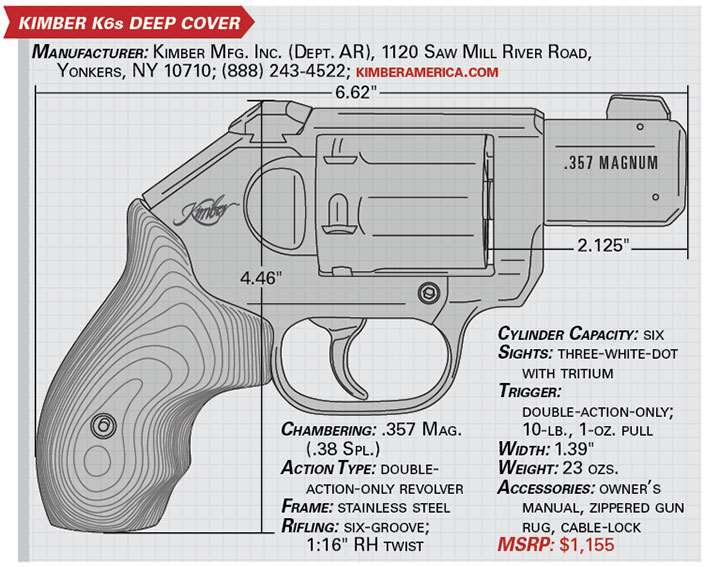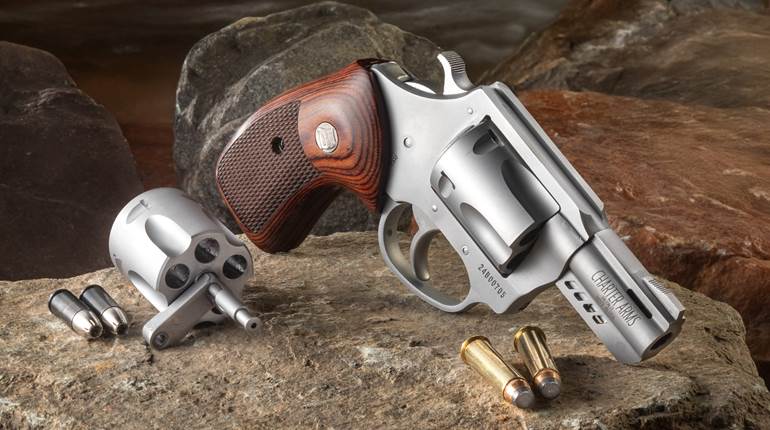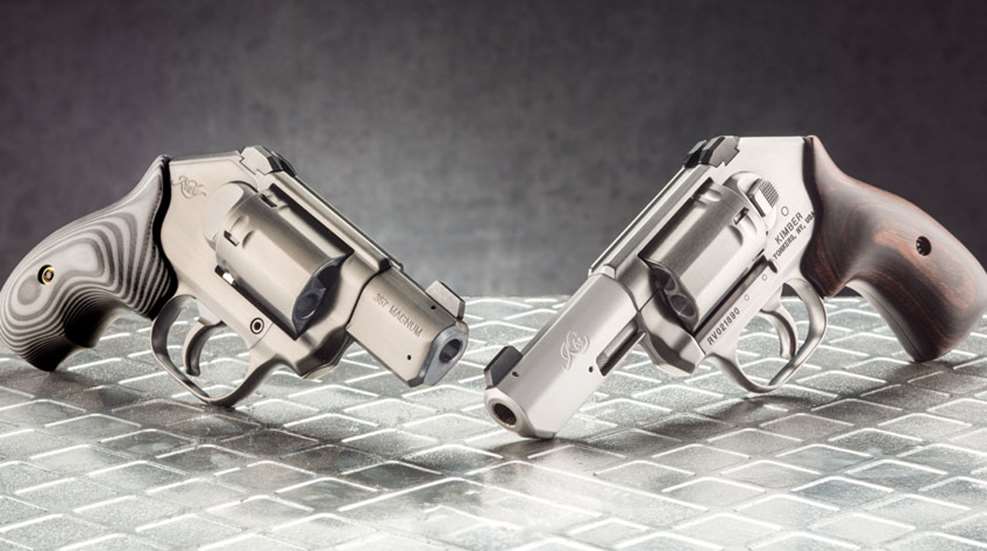
Until recently, Kimber specialized in high-end sporting and tactical rifles, pocket pistols and seemingly endless variations of the beloved M1911 .45 service pistol. With those observations, we can examine a firearm introduced not as a follow-on to any previous platform, but a traditional gun made for the first time by Kimber. Called the K6s, it is a six-shot .357 Mag. revolver. That’s right, a revolver.
The demise of the revolver has been loudly proclaimed at gun store counters across the land, but perhaps that has been exaggerated. Undeniably, sales of the American-familiar wheelgun have tapered off significantly. No longer do the majority of the nation’s police officers go to work with them. Although still viable, the medium-size service revolvers—Ruger GP100s, K- and L-frame Smith & Wessons and I-frame Colts—no longer compete for the implied endorsement of law enforcement use. This leaves the large and powerful sportsman’s revolvers, as well as the small, concealable snubbies. Good quantities of the former still sell well, and the latter are as popular as they ever were.
Kimber chose to develop and market a compact, short-barreled revolver because it has a good chance of commercial success. Intended for the ever-growing concealed carry market, the K6s is a type of revolver that has been produced in America since just after the Civil War. Many companies made revolvers of this class, which has long been identified as the so-called “hammerless.” As with other such wheelguns, the K6s actually does have a hammer—it is internal, completely enclosed and so cannot be manually cocked. The mechanism is double-action-only, where trigger pressure turns the cylinder and cocks the hammer, then fires the gun. It is a very simple system, and simplicity is often best in a defensive arm. There is a further advantage in the sense that an internal hammer has no cocking spur to snag on clothing or gear. In addition, such a small, defensive gun can be maneuvered in and out of pocket or purse with great efficiency.
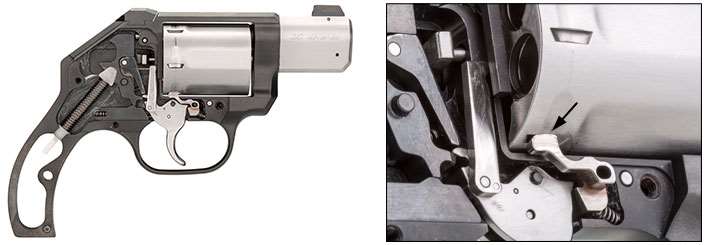
Kimber’s new creation is a fine example of the form. It is made of steel, except for the polymer stocks (also offered in G10 and various walnut configurations, depending on the model), and weighs 23 ozs. Chambered for the .357 Mag. cartridge, the K6s has six chambers in the cylinder. It should be noted that comparable guns from other makers are usually five-shots. Despite its capacity, the Kimber measures a reasonable 1.39" in width. The barrel is the traditional 2" size with an actual length of 2.125". Overall, the Kimber is 6.62" long and 4.46" in height. The stocks on my shooting sample are a version of the Boot Grip pioneered by Craig Spegel. Despite the gun being an enclosed-hammer revolver, the contours are distinctly different from all others.
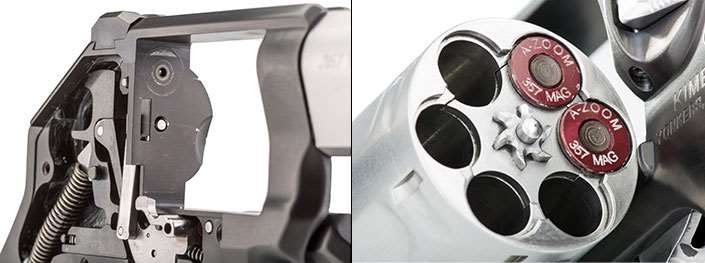
Since Kimber designers started with a blank sheet of draft paper, its engineers had no constraints imposed by tradition. The stainless steel frame of the K6s is completely new and different. There is an obvious effort to build a firearm to be carried on the person with ease and even comfort. Every major edge or corner on the frame is beveled or radiused. This means no edge or corner is likely to create a problem by giving up the gun’s profile through light clothing, nor is the gun as inclined to dig into the shooter’s body. The “melted” nature of the K6s also means a quicker draw from concealment when the tactical circumstances dictate. Even the cross-hatched cylinder latch is smoother than the competition. That latch, by the way, rocks inward in much the same way as those of Ruger double-action revolvers.
Other contours on the little revolver contribute to its fine overall ergonomic design. The trigger guard is a bit elongated to give the trigger finger plenty of room. On the revolver’s barrel, there is an underlug to protect the ejector rod, and the cross section of that part is somewhat ovate; it’s both graceful and practical. Inside the underlug, there is a spring-loaded detent that presses inward on the cylinder rod. The cylinder has recessed chambers so the cartridges are flush with the back of the cylinder face. Also, in contrast to most American revolver makers, which lighten their guns’ cylinders by cutting flutes between the chambers, the K6s achieves a clean, modernistic appearance through the use of flats instead of flutes.
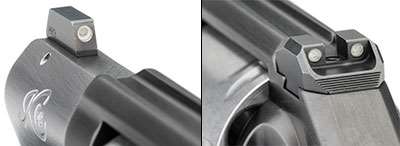
Kimber is a company that likes to offer its customers lots of options. At the time of writing, Kimber offered at least six versions of the K6s with distinct color and feature combinations: CDP, DC, DCR, Stainless, TLE and engraved Special Editions. In the time it took the editors to put this story together, Kimber introduced both 3" barrels and an external-hammer DA/SA model that stands, of course, for double-action/single-action. That’s a gun for another time.
I used the double-action-only K6s DC as the main gun for this review, and DC stands for “Deep Cover.” Finished in a businesslike gray-black DLC, the little gun lives up to the name. Also note that the DC version comes with three-dot tritium night sights. While the front sight is pinned into the top rib of the barrel in a conventional style, the rear sight is different. Located at the top rear corner of the frame, the rear sight is a separate block of steel dovetailed into the frame. It presents a wide, deep notch to the shooter as he prepares to fire. In most snubby revolvers with fixed sights, the notch is rather small, almost vestigial; this one is a full, 1/8" wide and works well. A small amount of windage adjustment is available by moving the sight laterally, and both front and rear units are replaceable.
I took the Kimber to an advanced pistolsmith with decades of experience inside handgun mechanisms. That gentleman and I disassembled the gun and observed its action. The K6s has a sideplate on its right, secured by three screws, only one of which is visible without removing the stocks. Inside, it’s different from any of the Colt, Smith, Ruger or Taurus revolvers he has worked on in the past, but, with its internal hammer and coil mainspring on a strut, probably bears more resemblance to the S&W than anything else. The hand comes up through the recoil shield’s right to advance the cylinder, while the locking bolt comes up through the right side of the frame between it and the sideplate to lock into recesses cut into the cylinder between chambers.
Kimber did a great job with this gun, as the action is very good. The trigger weight seems a bit lighter than most current-production revolvers, being just over 10 lbs. Dry-firing the gun builds an appreciation for the mechanical design and its execution.
As a revolver intended for close defensive roles, the Kimber K6s is unlikely to see much shooting at distance. For this reason, we did the standard shooting protocol of five consecutive, five-shot groups at 7 yds., fired from benched sandbags. Although the K6s is a .357 Mag. revolver capable of handling any load in that chambering, many defensive shooters will shoot .38 Spl. For that reason, our ammunition list was two kinds of .38 Spl. and one.357 Mag. Accuracy with all three kinds of ammunition averaged well under the 2" mark. In view of the short barrel, instant recoil and minuscule sight radius, I’m pleased with that. It’s all tabulated on p. 49, but there is also a very interesting statistic to be derived from the table. Note the velocity of a 158-gr. bullet fired from a .38 Spl., as compared to the velocity of the same weight bullet from a .357 Mag. It is 426 f.p.s. more for the .357 Mag. Now compare the energy differential, which is calculated with a standard ballistician’s formula. It is roughly two-and-a-half times the blow—188 ft.-lbs. of energy for the .38 is nowhere close to 470 for the .357 Mag.
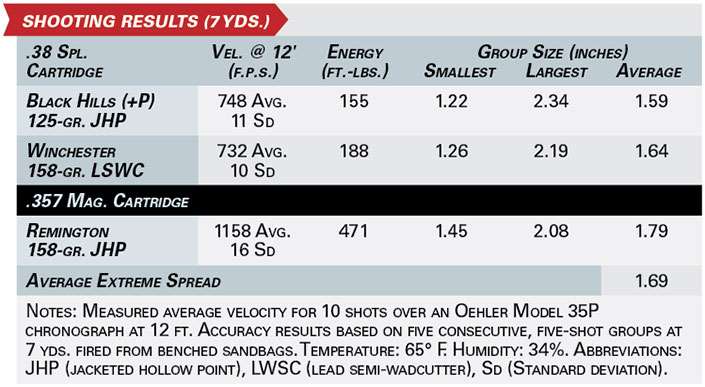
Recoil with .357 Mag. ammunition out of the K6s is severe but still manageable—after all, the gun weighs only 23 ozs. I found it to be notably stout. Part of reason is in the way the gun is shaped and the way it moves in the hand when fired. I freely concede that this is a subjective impression, and other handgunners may not see it the same way.
My local gun shop tells me that the Kimber K6s is hard to keep in stock, so it has achieved some degree of popularity. I’ve heard some criticism of the gun on the grounds that it is ugly or ungainly. Others think it is a beauty. Certainly the K6s profile is unusual, having a straight line running from the top rear corner of the frame all the way down to the backstrap. When you consider that this is a tool for the saving of its owner’s life, aesthetics must necessarily become a secondary consideration. It is very well made and sturdy, decently accurate and has a trigger action that is quite good. I have to wonder if that action might not find its way into a bigger service wheelgun someday. That would tend to stir up the pot, now wouldn’t it?
